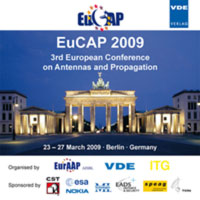Planar Two-Bit Phase Encoded Transpolarising Reflector using Textured Surface Technology
Conference: EuCAP 2009 - 3rd European Conference on Antennas and Propagation
03/23/2009 - 03/27/2009 at Berlin, Germany
Proceedings: EuCAP 2009
Pages: 4Language: englishTyp: PDF
Personal VDE Members are entitled to a 10% discount on this title
Authors:
Fusco, V.; Munir, A.; Euler, M. (The Institute of Electronics Communications and IT, Queens University of Belfast, Queens Rd, Queens Island, Belfast BT3 9DT, N Ireland)
Abstract:
We show that a suitably designed textured surface can be employed as a quadrature phase-shift keying (QPSK) backscattering reflector and as an electronically agile transpolarising reflector. The structure takes the form of an artificial magnetic conductor (AMC) that is printed on a Taconic CER10 substrate loaded with microwave varactor diodes incorporated onto the surface of the textured surface. It is shown that by adjusting the surface capacitance to each of four possible different states the proposed structure can generate four different phases of reflected signals thereby making the structure useful as a PSK backscattering reflector. In addition the structure is capable of encoding orthogonal TE and TM incident E-fields with up to eight independent PSK states. Simulation reveals that for the surface simulated at 2.88GHz the maximum expected reflection loss is only 0.36dB, and maximum QPSK phase error is 30. We also show that for this structure that we can synthesise two linearly polarised slant 45deg signals, hence use the surface as a planar twist reflector. In addition we can use the surface to transform a slant linearly polarised 45deg signal into either a right or a left hand circularly polarised reflected signals that itself can be digitally phase encoded with one of the four phase states, 0deg , 90deg, 180deg, 270deg. For the circularly polarised case the worst case axial ratio expected is 0.3dB along boresight.


